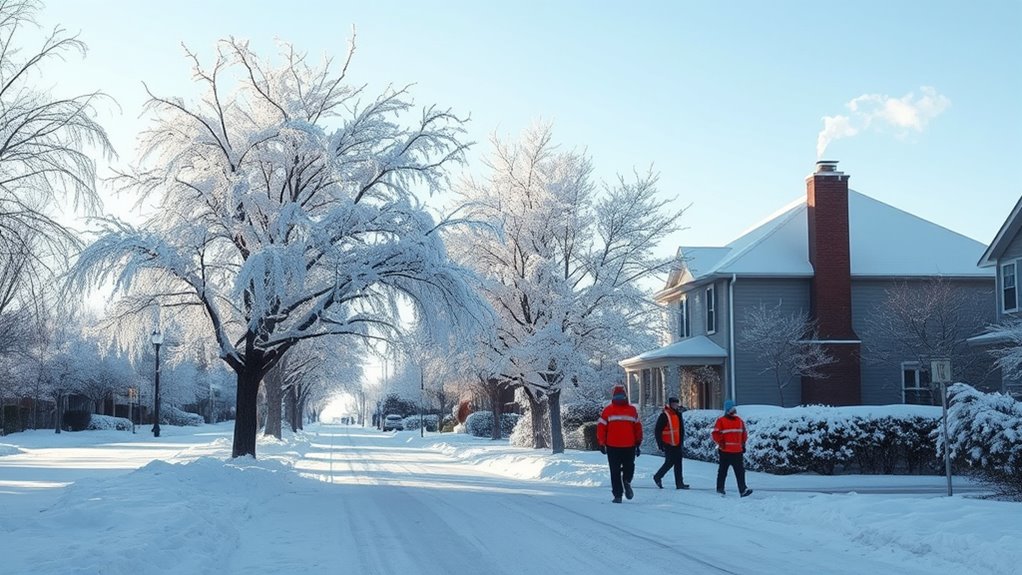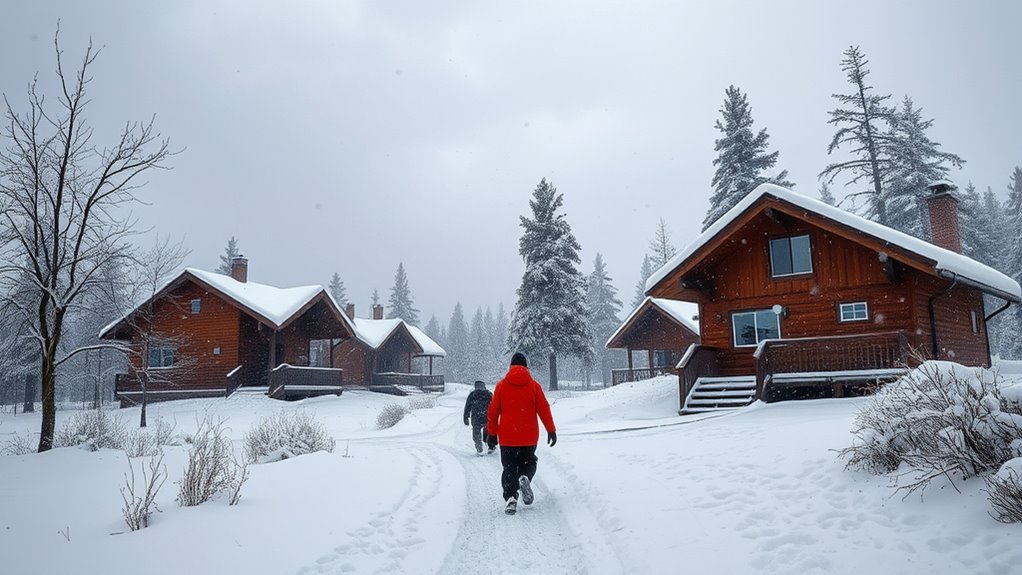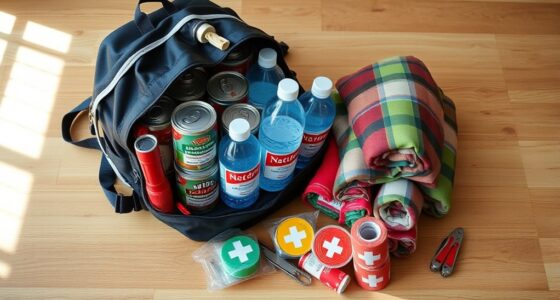To stay safe during extreme cold and winter storms, stock up on non-perishable food, water, warm clothing, and backup power sources. Dress in layers, keep extra blankets handy, and stay informed with weather alerts. Make sure your vehicle is prepared, and have emergency supplies ready at home. Knowing how to use these items and monitor updates can make all the difference. Keep learning how to be fully prepared to protect yourself and your loved ones.
Key Takeaways
- Stock enough non-perishable food, water, and emergency supplies to last several days before a storm hits.
- Dress in layers with thermal clothing, waterproof boots, hats, gloves, and keep extra blankets accessible.
- Keep cell phones charged, use backup power sources, and stay informed via battery-powered radios and weather alerts.
- Prepare your vehicle with fuel, winter supplies, and check tire, antifreeze, and windshield washer fluids rated for cold temperatures.
- Develop a safety plan including sheltering at home, avoiding unnecessary travel, and knowing how to use emergency supplies effectively.

Winter storms can strike suddenly and disrupt daily life, but being prepared makes all the difference. When harsh weather rolls in unexpectedly, your ability to stay safe depends on how well you’ve planned ahead. That’s why winter preparedness is essential; it helps you face the storm confidently, minimizing risks and ensuring you have what you need to weather the cold. One of the most crucial steps is gathering emergency supplies before winter’s worst hits. These supplies act as your safety net if the power goes out, roads become impassable, or you’re stranded at home. Start by stocking up on non-perishable food and bottled water, enough to last several days. Include a manual can opener, so you’re not dependent on electricity. Warm clothing, blankets, and sleeping bags are vital for staying warm if heating systems fail. Layering is key—wear thermal underwear, sweaters, and waterproof boots to keep yourself insulated and dry.
Make sure you have a reliable flashlight with extra batteries, along with a battery-powered radio to stay updated on weather alerts and emergency instructions. Power outages are common during severe winter storms, so consider investing in a portable charger or backup power source for your cell phone. Keep extra blankets, hats, gloves, and scarves accessible, especially if you have vulnerable family members or pets. Don’t forget basic first aid supplies, including bandages, antiseptic, and any necessary medications. It’s also wise to have a supply of snow shovels, ice melt, and sand or kitty litter to clear walkways and prevent slips. Maintaining adequate sleep and staying alert to changing weather can improve your decision-making and overall safety during emergencies. Additionally, understanding the different cookie categories used in online safety can help you better control your digital privacy during stressful situations.
In addition to physical supplies, prepare your vehicle. Keep it fueled and stocked with essentials like a blanket, water, snacks, and a first aid kit. Check your car’s tires, antifreeze levels, and ensure your windshield washer fluid is rated for low temperatures. During winter storms, avoid unnecessary travel; if you must go out, let someone know your route and estimated arrival time. Keep your phone charged, and have a car charger handy. Staying informed about weather conditions through alerts and updates allows you to make timely decisions—whether to stay home, seek shelter, or evacuate if necessary.
Ultimately, winter preparedness isn’t just about having supplies; it’s about knowing how to use them and staying alert to changing weather patterns. When you’re equipped with emergency supplies and a clear plan, you’ll be better positioned to stay safe and resilient through even the harshest winter storms. Preparation is your best defense against the cold’s dangers—so take action now, and face winter with confidence.
Frequently Asked Questions
How Can I Prevent Frozen Pipes During a Winter Storm?
To prevent frozen pipes during a winter storm, you should insulate exposed pipes with pipe insulation to keep the cold out. Also, consider wrapping your water heater with heat tape to maintain a higher temperature. Keep your home heated adequately, especially in unheated areas like basements and attics. Letting faucets drip slightly can also prevent freezing. These steps help make certain your pipes stay safe and functional during extreme cold.
What Should I Include in an Emergency Winter Kit?
In your emergency winter kit, you should include essential supplies for winter safety. Pack warm clothing, blankets, and sturdy boots to stay warm. Include non-perishable food, water, and a flashlight with extra batteries. Add a first aid kit and necessary medications. Don’t forget a manual can opener, a multi-tool, and a phone charger. These emergency supplies will help you stay safe and comfortable during winter storms or power outages.
How Do I Safely Start a Car in Extreme Cold?
When starting your car in extreme cold, verify your car battery is well-maintained and fully charged, as cold weather weakens batteries. Use the correct engine oil for low temperatures to help the engine turn over easily. Turn off all accessories, wait a few seconds after turning the key, then start the engine. If it struggles, give it a few more seconds or try again to avoid damage.
Are There Specific Clothing Recommendations for Freezing Temperatures?
When you’re in freezing temperatures, you should wear thermal layering to trap heat and stay warm. Opt for waterproof gear to keep moisture out, which is essential in cold, wet conditions. Make sure your clothing covers all exposed skin, and wear insulated gloves and a hat. This combination helps you stay dry and retain body heat, reducing the risk of frostbite and hypothermia while you’re outdoors.
How Can I Protect Outdoor Pets During Winter Storms?
Think of your outdoor pet as a loyal friend needing extra warmth and comfort. To protect them during winter storms, guarantee indoor pet safety by bringing them inside during extreme cold. If outdoor shelter tips are necessary, provide a well-insulated, dry shelter elevated off the ground, with plenty of bedding. Keep fresh water accessible, and monitor them closely to prevent frostbite or hypothermia. Your care keeps their spirit warm despite the chill.
Conclusion
Stay safe and stay smart during winter storms by preparing promptly and practicing patience. Prioritize your safety, plan your pathways, and protect your property. Remember, preparedness prevents peril, and awareness averts accidents. By being vigilant and vigilant, you’ll vanquish the vexing vulnerabilities of the freezing forecast. Embrace the essentials, empower your efforts, and endure the icy ordeal with confidence. With careful consideration and committed caution, you can conquer the cold and carry on comfortably.









